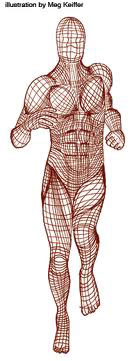Here’s a delicious recipe that promotes digestion and is loaded with anti-inflammatory properties. Caroline came across it in Adina Niemerow’s book “Super Cleanse.” It’s easy to make and keeps in the refrigerator for up to a week. It’s an alternative to store bought cereals that usually contain wheat and sugar (yes, evaporated cane juice is still sugar).

Apple/Almond Breakfast Porridge
- ¼ cup Almonds (soaked overnight and drained)
- 2 Cored, and chopped green apples
- 2 Chopped figs
- juice of half a fresh lemon
- ¼ tsp Peeled, and finely minced ginger
- 1 tbsp Flax ground seeds
Blend the first 5 ingredients in a food processor; scoop out into a serving bowl and sprinkle with ground flax seeds.
Option: add almond milk or fresh yogurt
You can also adjust ingredient amounts according to your taste.




 Place your arms directly out to the sides at shoulder height with your palms down. Imagine someone is pulling on each arm so that you feel a slight distraction from the shoulder joints. Slowly rotate your outstretched arms forward, keeping them at shoulder height. You should feel a stretch throughout your arms and into the backs of your shoulders. After feeling a few releases in that direction, you can rotate your palms up and back opening up the fronts of the arms and your chest. You can look up to open up the front of your neck as well. Take a few breaths here and then release slowly.
Place your arms directly out to the sides at shoulder height with your palms down. Imagine someone is pulling on each arm so that you feel a slight distraction from the shoulder joints. Slowly rotate your outstretched arms forward, keeping them at shoulder height. You should feel a stretch throughout your arms and into the backs of your shoulders. After feeling a few releases in that direction, you can rotate your palms up and back opening up the fronts of the arms and your chest. You can look up to open up the front of your neck as well. Take a few breaths here and then release slowly. Here’s a tasty quinoa recipe that we hope you will enjoy. It’s loaded with fresh herbs, lemon and protein rich quinoa. Quinoa (pronounced keen-wah) is considered a complete protein because it contains all the essential amino acids necessary for our nutritional needs. Although it is cooked and eaten like a grain, quinoa is technically a seed, and is related to spinach, chard and beets. It’s also high in iron and calcium, and is a good source of manganese, magnesium and copper, as well as fibre. It makes a delicious alternative to rice and other grains.
Here’s a tasty quinoa recipe that we hope you will enjoy. It’s loaded with fresh herbs, lemon and protein rich quinoa. Quinoa (pronounced keen-wah) is considered a complete protein because it contains all the essential amino acids necessary for our nutritional needs. Although it is cooked and eaten like a grain, quinoa is technically a seed, and is related to spinach, chard and beets. It’s also high in iron and calcium, and is a good source of manganese, magnesium and copper, as well as fibre. It makes a delicious alternative to rice and other grains.